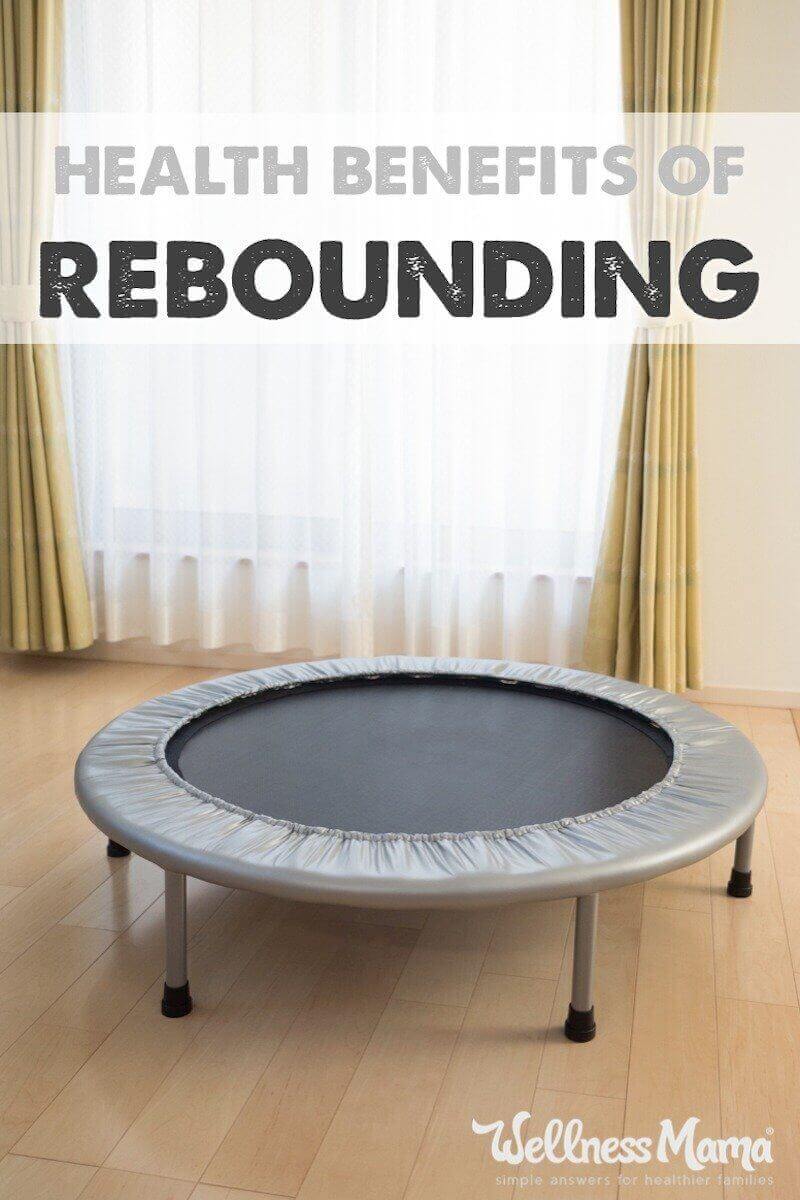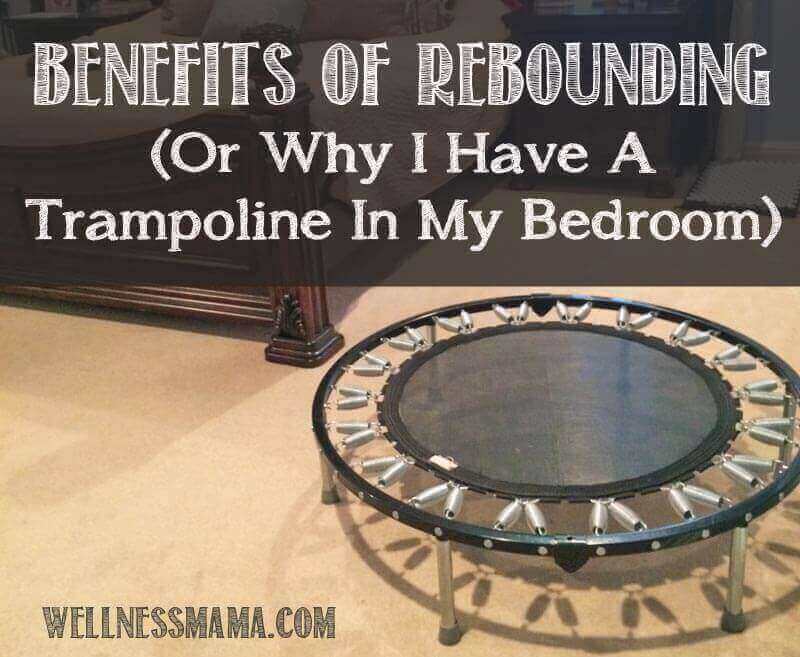Rebounding is an exercise I do daily, but I must admit that when I first heard about it, the idea sounded crazy. If you aren’t familiar with it, rebounding is basically jumping on a mini trampoline either in gentle bounces where your feet don’t leave the trampoline or in complete jumps where you rise 6 inches from the surface.
Why Rebound?
Glad you asked. Turns out that there are many benefits to rebounding (including NASA’s research showing that rebounding can be more than twice as effective as treadmill running).
The idea of rebounding has been around for a long time, but it gained popularity in the 1980s when NASA studied its benefits while trying to find an effective way to help astronauts recover and regain bone and muscle mass after being in space. Astronauts can lose as much as 15% of their bone and muscle mass from only 14 days at zero gravity, so NASA needed a way to help reverse this damage.
Some of the findings of the NASA study:
- When the astronauts were tested while running on a treadmill, the G-force measured at the ankle was over twice what it was at the back and head. This means that the foot and leg absorb much of the force when running, which can explain the higher rates of foot, shin and knee problems from running (especially running incorrectly). On a trampoline, the G-force was almost identical at the ankle, back and head and at a lower level than that of the G-force at the ankle on a treadmill. This shows that rebounding can exercise the entire body without excess pressure to the feet and legs.
- “The external work output at equivalent levels of oxygen uptake were significantly greater while trampolining than running. The greatest difference was about 68%.” In other words, the increased G-force in rebounding means you get more benefit with less oxygen used and less exertion on the heart.
- ” . . averting the deconditioning that occurs during the immobilization of bed rest or space flight, due to a lack of gravireceptor stimulation (in addition to other factors), requires an acceleration profile that can be delivered at a relatively low metabolic cost. . .for equivalent metabolic cost, and acceleration profile from jumping will provide greater stimuli to gravireceptors.” In other words, the acceleration and deceleration of rebounding provides benefits on a cellular level and at a greater rate than other forms of exercise like running.
How Rebounding Works
Many types of exercise are done to target specific muscles or just to increase cardiovascular function. Rebounding is unique since it uses the forces of acceleration and deceleration and can work on every cell in the body in a unique way.
When you bounce on a rebounder (mini-trampoline), several actions happen:
- An acceleration action as you bounce upward
- A split-second weightless pause at the top
- A deceleration at an increased G-force
- Impact to the rebounder
- Repeat
The action of rebounding makes use of the increased G-force from gravity based exercises like this and each cell in the body has to respond to the acceleration and deceleration. The up and down motion is beneficial for the lymphatic system since it runs in a vertical direction in the body.
Another study showed that the increased G-force helped increase Lymphocyte activity. The lymph system transports immune cells throughout the body and supports immune function. For this reason, rebounding is often suggested as a detoxifying and immune boosting activity.
Rebounding, since it affects each cell in the body, can also increase cell energy and mitochondrial function.
One of the major benefits of rebounding is its benefit to the skeletal system. Just as astronauts lose bone mass in space as a response to the decreased need for strong bones in a zero gravity environment, weight bearing exercise increases bone mass. Rebounding is especially effective at this since it increases the weight supported by the skeletal system with the increased G-force of jumping.
James White, Ph.D., director of research and rehabilitation in the physical education department at the University of California at San Diego (UCSD), has explained how jumping for health offers a true physical strengthening effect to the muscles.
“Rebounding allows the muscles to go through the full range of motion at equal force. It helps people learn to shift their weight properly and to be aware of body positions and balance,” says White.
An advocate of rebounding for athletic conditioning, White uses the rebounder in his rehabilitation program at UCSD. “When you jump, jog, and twist on this [jumping] device, you can exercise for hours without getting tired. It’s great practice for skiing, it improves your tennis stroke, and it’s a good way to burn off calories and lose weight,” says White. (source)
Benefits of Rebounding
I mentioned many of these above, but here are the benefits of rebounding without all the science and sources:
- Boosts lymphatic drainage and immune function
- Great for skeletal system and increasing bone mass
- Helps improve digestion
- More than twice as effective as running without the extra stress on the ankles and knees
- Increases endurance on a cellular level by stimulating mitochondrial production (these are responsible for cell energy)
- Helps improve balance by stimulating the vestibule in the middle ear
- Helps improve the effects of other exercise- one study found that those who rebounded for 30 seconds between weight lifting sets saw 25% more improvement after 12 weeks than those who did not.
- Rebounding helps circulate oxygen throughout the body to increase energy.
- Rebounding in a whole body exercise that improves muscle tone throughout the body.
- Some sources claim that the unique motion of rebounding can also help support the thyroid and adrenals.
- Rebounding is fun!
How to Start Rebounding
Essentially, it is as easy as starting to bounce daily. Most sources I’ve seen recommend rebounding for 15 minutes or more a day, though this can be broken in to multiple 3-5 minute groups.
Though rebounding is a gentle activity, it is best to start with feet on the rebounder and only gentle jumps and work up to jumping with feet leaving the rebounder.
Personally, I jump on the rebounder for a few minutes when I wake up, then dry brush my skin (both are good for avoiding cellulite) and then shower. I also jump on the rebounder a few times a day when I remember. I keep it in my bedroom, so I usually remember when I go in my room to fold laundry or change clothes.
There are a lot of different models of rebounders to choose from. The more expensive models are supposed to have better springs to reduce the impact to joints, but any small trampoline will work. Here are a few I’ve personally tried:
- This Needak Rebounder (the one in my room)
- This Jump Sport Rebounder (a little cheaper) – One of my friends’ favorites.
- A Stamina 36 inch Rebounder (cheapest option, only $59) – Another friend has one of these and likes it a lot.
Ever tried rebounding? Will you give it a go? Tell me below!



Leave a Reply